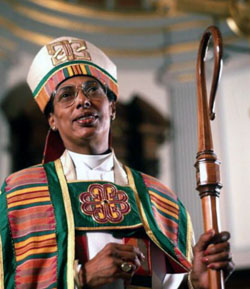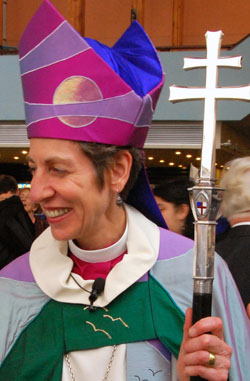
Bishop Harris’ vestments were made from Kente cloth from Ghana and, for a good time afterwards, women preparing for ordination would ask for a small remnant to incorporate into their own.
Vestments and paraments (frontals, falls, banners) are great tools to help tell the old, old story. To paraphrase a great Churchillian aphorism, all art — Winston said architecture — is influenced by the culture in which it is created and then influences the culture that follows.
When the church is live, when it’s in dialogue with its culture, its vitality will reflect and be reflected in its art. When it is stagnant, it will tend to repeat the same old patterns over and over with each layer morestultifying than the last. Clothes wear out and need to be replaced more frequently than buildings, making vesture far more nimble in reflecting the zeitgeist than architecture and other long-lived arts.
A Short History
The antique, first century Roman or medieval origin of vestments gives instant visual expression to ecclesiastical continuity, while the ease of adapting their design and ornamentation to modern sensibilities can create an exciting dialogue with their setting, whatever its period, style or age. We created abstract-patterned, multi-colored pulpit robes for The Riverside Church in New York City. Later a member told us she had never really paid much attention to theclerestorywindows until a Sunday when all the clergy were gathered in their new robes. Suddenly, she said, the colorful modern robes seemed to pull all the glorious colors of the traditional stained glasswindows down into the sanctuary giving the whole space new life.
The way in which tradition, form, color and design of vestments can enter into an instant visual dialogue with setting and congregantsshould not be underestimated. Our age is one in which visual communication — think photography, cinema, television — has equaled, if not surpassed, the power of the written and spoken word to proclaim the story of Jesus and his love, and can bring renewed life to the liturgical core of our spiritual formation.
Religion no longer enjoys the social support it once did. When I was a lad, commerce stopped on Sundays and from noon to three on Good Friday. It was a time when Americans seemed to come in only three flavors of piety, Catholic, Protestant and Jews. No longer. Commerce clamors for our attention 24/7. Religious diversity and laxity have exponentially expanded. It all seems to be happening faster and faster.
Adding to this, by the end of the second millennium AD the Episcopal Church was changing from old guard establishment to a ministry focused on justice. This has been exciting for some but confusing and uncomfortable for others. While vestments reflect, rather than set, the agenda, we would suggest church vestments of contemporary design are a stealth way of smoothing the transition from old image to new reality, sharpening our vision of who we are as God’s people and what we believe God is calling us to be and do.

Bishop Gene’s vestments (above) celebrated the people of the Diocese of New Hampshire in all their diversity, as well as the many who had felt cast out and who now felt welcome.
Contemporary Vestment Design
Think how three defining moments and messages were enhanced by the vestments created for them: the consecrations of Barbara Harris and Gene Robinson to the episcopacyand the installation of Katharine JeffertsSchorias Presiding Bishop and Primate.
In 1988, Barbara Harris, in being consecrated as Bishop Suffraganof Massachusetts, became the first woman to be a bishop in the Episcopal Church, Anglican Communion and Catholic west. Bishop Harris asked us to design vestments for the occasion. We started the design process but couldn’t begin stitching until the consents came in. Some standing committees voted yes, then no, then yes, or vice versa. Bishops kept their finger in the wind until the last minute to see in what direction the Spirit, or at least their windy college, was blowing. With the consent deadline nearing, one evening just before dinner, the phone rang. It as Barbara. Her first words were, “Get out the needles, boys.” It was a go.
The vestments were a full-cut, off-white silk but what made them special was a rose-colored, women’s weave Kentecloth from Ghana we found in a display at the American Museum of Natural History in New York. At the consecration itself, perhaps more than in anything else, it was Bishop Barbara’sdonning of the miter and the joyous cacophony that followed that proclaimed for the first time in history, “She is a bishop.” How much this meant became evident when, for a good time afterwards, women preparing for ordination would ask if we had even a small remnant of the fabrics used for the Harris vestments that might be incorporated into their own.
“Stir up you power, O Lord,” begins the ancient collect for the Third Sunday of Advent. Stirred up doesn’t begin to describe the 2003 General Convention’s strategically-timed election of gay, partnered and out-of-the-closet Episcopal candidatefor Bishop Coadjutor of New Hampshire, Gene Robinson. After much debate, deputies and bishopsgave their consents to the election. When he contacted us or we contacted him I can’t remember, but we were commissioned to create the vestments for a bishop-elect whose consecration would shake the Anglican Communion.
Bishop Gene’s one requirement was that the vestments celebrate the people of the Diocese of New Hampshire in all their diversity. Our inspiration came from the mountains and forests of the state. To represent the people, we appliquéedsilk leaves of many colors on a gold-toned firesilk. The cope and chasublecame to represent not only the people of New Hampshire but also the many who had felt cast out and who now felt welcome. It was a sign we were beginning to live into Presiding Bishop Browning’spromise that, “In this church there shall be no outcasts.”

Presiding Bishop Katharine’s vestments (below) represented her beloved western mountains and the dawning of a new day for women the world over.
In 2006 Katharine JeffertsSchoribecame the first woman elected Presiding Bishop and Primate of the Episcopal Church and first to be the primate of province of the Anglican Communion. When we caught our breath, we wrote to ask if we might make her investitureregalia. After a long pause, a note came asking us to arrange an appointment with her at 815. After perusing many designs, she came upon a quick sketch of mountains and a rising sun. That was it. The vestments would represent both her beloved western mountains and the dawning of a new day for the Episcopal Church and the Anglican Communion. The feminine symbol of the moon on the miter spoke to women the world over and the water-like colors reinforced Presiding Bishop Katharine’scall to us to “Live into our baptismal covenant.
In each of these moments defining our life togetherin the Episcopal Church, the very contemporary, somewhat off-beat design of the vestments visually reinforced the message of the moment. Some found that offensive. Most saw hope. Those who think of vestments only in terms of aesthetics or style tended to miss the point altogether.
The vestments we use in our parish churches may not represent big moments like those above, but they speak volumes about who we are, how we see ourselves and where we are headingas the people of God. A design that is old-fashioned, or simply old, or standard, mass-produced and from a catalog tends to say, “Not quite ready for the promised land.” Contemporary vestments expressly designed by artists, and there are a lot around to do the joy, will say, “We’re alive. We know who we are. Join us on our journey.”
In 1985, the Rev. Paul Woodrumpartnered with Mr. Victor Challenorto form ChallwoodStudio with the express goal of trying to liven things up in the church by designing and crafting contemporary custom vestments and paraments. Victor brought to the partnership his experience and spirituality as the first African American, life-professed lay brotherin the Episcopal Order of the Holy Cross. Fr. Paul brought pastoral experience and a keen interest in church architecture as a means of giving expression to theology.
by The Rev. Paul Woodrum
